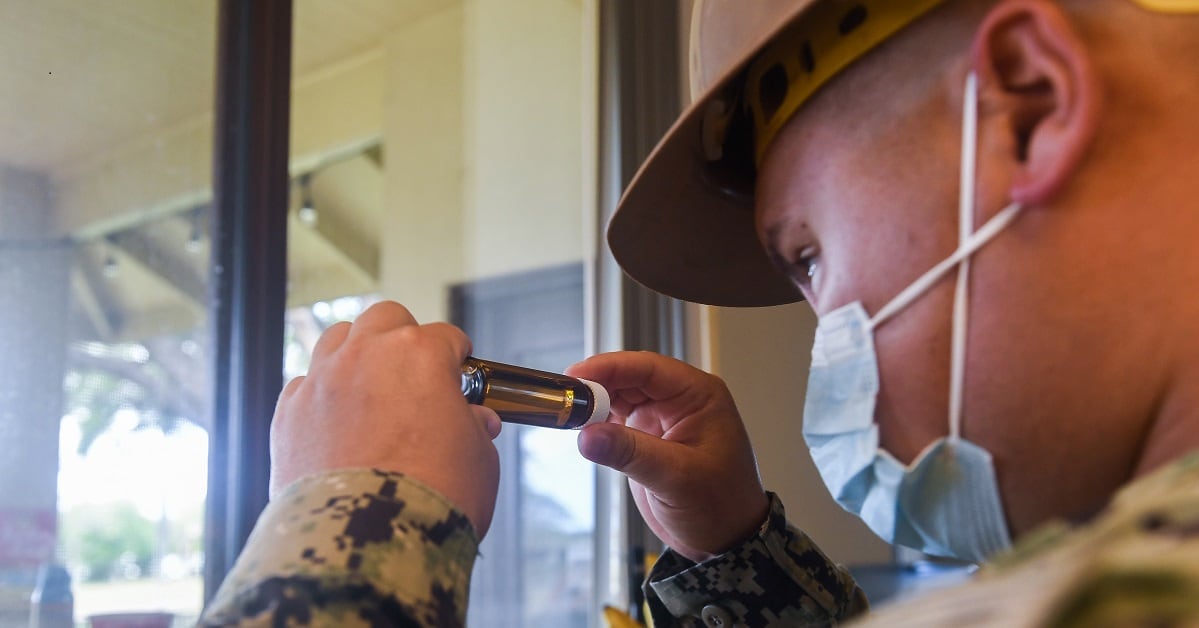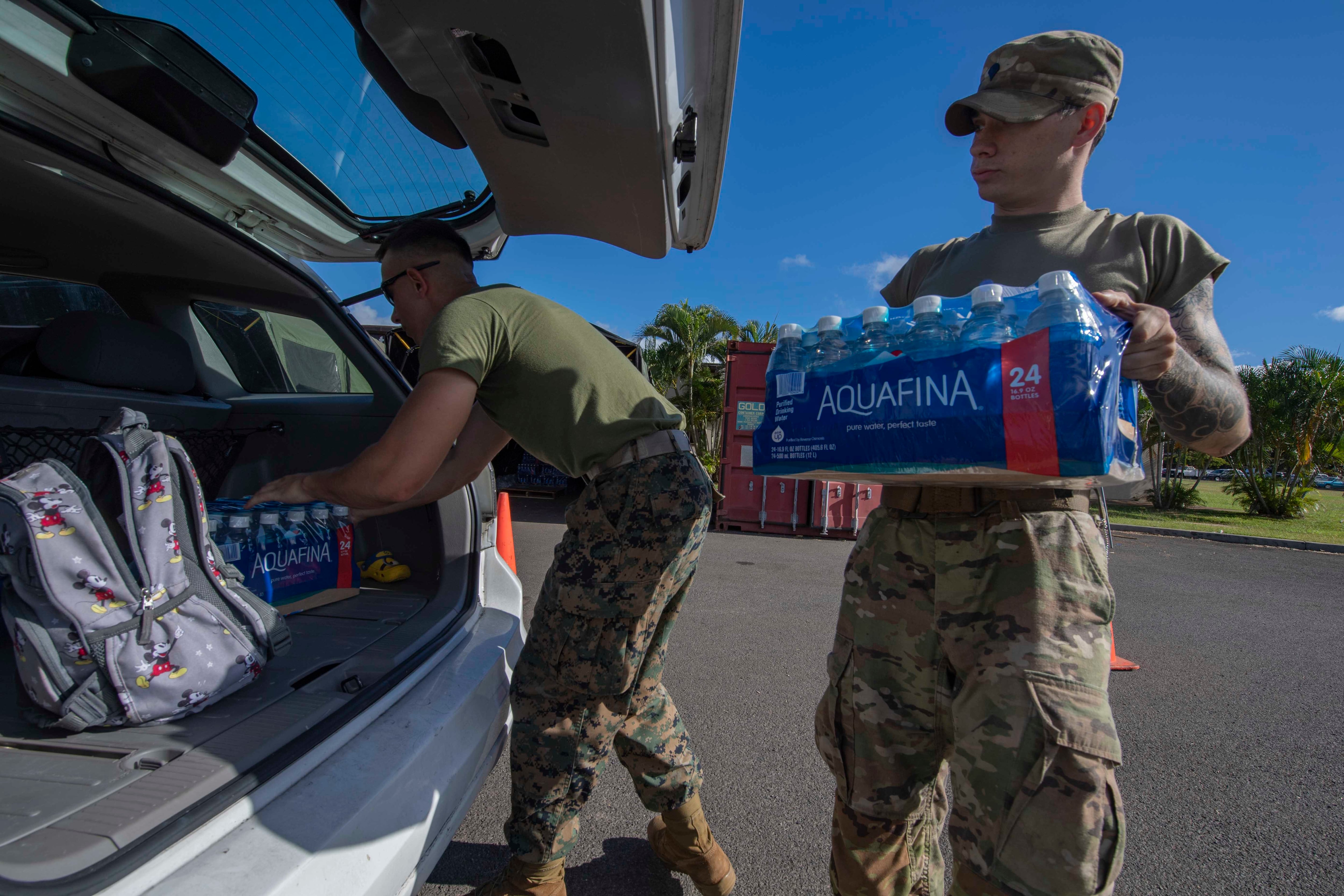Military medical officials have formed a joint working group to address the immediate health issues of service members and families affected by the fuel-tainted water in Hawaii, but little is known about what the long-term health effects could be.
It’s also not clear how the newly established Defense Department incident registry will track families into the future. All residents and assigned personnel on the affected water system are being automatically enrolled in the registry.
“We’re taking all the complaints that have manifested seriously,” said Navy Capt. Michael McGinnis, the U.S. Pacific Fleet surgeon and senior medical adviser, during a live Joint Base Pearl Harbor-Hickam Facebook update March 10. Some 9,715 households were affected by the fuel spill that entered the Navy’s water distribution system. Families were authorized to move to hotels at government expense in early December, and many of them have been living in hotels for more than three months. Families who chose to stay in their homes have been provided with potable water, shower facilities, laundry facilities and other services.
Those include Army and Air Force neighborhoods, as well as the Navy neighborhoods. There were 19 zones affected and an interagency team has been coordinating the flushing of contaminants in the water system and testing of the water. As of March 15, all but four zones had been cleared for safe drinking water by the Hawaii Department of Health. Of those 9,715 homes on the Navy water system, 90% — or 8,765 — have been cleared for safe water and residents have moved back.
But some families have reported persistent smells or sheens in the water after returning to their homes. One resident said she still saw a sheen in her water after running the taps for three days to clear any stagnant water. Officials have a rapid response team to address the issues, and will come to the home to assess the situation and conduct testing. As of March 15, the team had received 155 calls from residents and conducted 112 tests, with no detections of the JP-5 kerosene-based jet fuel in the water, according to a Facebook update March 16.
What about long-term health effects?
McGinnis acknowledged that questions have been raised by service members and families about the long-term effects of this exposure to the fuel in the water.
“Based on what we know, as far as the duration and the intensity of exposure from this event, we do not anticipate long-term health concerns,” McGinnis said. “But we don’t know definitively, and that’s why we want to monitor over time.”
The health effects of JP-5, JP-8 and Jet A fuels depend on how much of these fuels you are exposed to and for how long, CDC officials told Military Times. “Unfortunately, we know very little about the human health effects caused by” these fuels, they said.
According to a public health statement about these fuels on the CDC website, there are no reliable studies of cancer in humans exposed to these fuels.
Exposure to those fuels mainly occurs in occupational settings where children aren’t likely to be exposed, according to that CDC public health statement, and no studies on the health effects of exposure to these fuels in children were found.
RELATED

“The question is, how do we ensure over time that we are aware of the potential health impacts of the water?” McGinnis said.
“Specifically, the DoD has established an incident registry to capture all the individuals that may have been exposed to this contaminated water event,” McGinnis said March 10. “We’re capturing the families that live in housing on the Navy water distribution system, as well as the commands and for the active duty and DoD personnel that work on bases that are supplied” by the water system.
In response to the crisis, Navy officials established a joint health services working group — a joint medical team comprising operational medical forces and senior leaders in Hawaii’s military treatment facilities, McGinnis said. They’re also in close contact with the Hawaii Department of Health, he said.
“We are monitoring calls that come in, as well as patient visits to all our military treatment facilities, because we want to be very aware of what our families and our beneficiaries are experiencing, and being sure that we’re not missing anything,” he said.
Most military families stationed in Hawaii leave after a few years.
Navy officials did not respond to Military Times’ questions about how specific connections will be made between patients and that registry in the future, to inform their future medical providers of their exposure, such as through the Military Health System Genesis electronic records system.
Surveillance
On Nov. 28, military families reported smelling fuel odors and seeing an oily film in their tap water. But some had reported mysterious abdominal pain, vomiting, memory loss, skin rashes, eye irritation, and teeth and gum issues even before the signs of fuel appeared.
Navy officials have said it appears that an unknown quantity of JP-5 jet fuel entered the Red Hill well in a single event, likely from a fuel spill Nov. 20, and then it was subsequently pumped from that well and distributed across portions of the Navy water system.
It’s not clear whether military health care providers were communicating with each other about their patients’ unexplained symptoms before Nov. 28.
Military Times asked defense officials on Dec. 17 whether there is any surveillance system or central communication system within military treatment facilities that would have alerted medical officials about these mysterious symptoms and the possibility of a larger problem. The questions were referred to the Navy and, as of March 17, service officials had not responded.
RELATED

Currently, there is no law or mandate that requires federal agencies, including the military service branches, to report symptoms to the Centers for Disease Control and Prevention, according to a statement that the CDC provided to Military Times.
The CDC’s Agency for Toxic Substances and Disease Registry depends on state, local and federal agencies to inform them of chemical releases and suspected human exposures to hazardous substances, according to the statement. When these happen, the agency’s Assessment of Chemical Exposures program helps state and local health departments conduct rapid epidemiological assessments. Among other things, state and local health departments can use the information to identify a group of exposed people who may need to be followed for long-term effects.
The CDC and Hawaii Department of Health conducted an online survey of those living and working in the area who were affected by the fuel spill, including Hawaiian civilian residents as well as those in the military community.
Through the new joint health services working group, there is now surveillance of these military families in Hawaii, McGinnis said during the live Facebook update March 10. With discussions between the operational medical leadership and the military treatment facility leadership, he said, “we’re closely coordinated and aware so that if anyone is seeing something, we’re able to quickly communicate that across the board, as well as inform our providers as far as this event and bring the subject matter experts to inform them as they evaluate our patients, one on one to ensure that we’re addressing all concerns completely.”
He advised people with health concerns to schedule an appointment with their primary care provider; communicate through the secure messaging app through the Military Health System Genesis portal; or contact the nurse advice line.
Testing concerns
Families have repeatedly expressed concern about the lack of testing available for family members, while active duty members with symptoms were given a battery of tests.
According to the CDC, “in general, jet fuels and their metabolites leave the human body fairly rapidly. Tests to detect these chemicals need to be conducted within days of exposure.” To date, the CDC has not recommended any tests for this incident, officials told Military Times.
“The chemicals in JP-5, JP-8, and Jet A fuels can enter your body through your lungs, digestive tract, or skin,” CDC officials said in the statement. “We do not have information on how much of the chemicals in JP-5, JP-8 or Jet A fuels can pass into the bloodstream, but we do know that large amounts of some of the chemicals in jet fuels can easily do so.
“The chemicals in JP-5, JP-8 or Jet A fuels will be eliminated from the body in the urine, feces, or breath.”
McGinnis said he is aware of those questions about tests, and said families who have a concern or complaint should contact their medical provider for evaluation.
“Certainly our providers will order whatever tests are indicated,” he said. But, “in this specific incident, biomonitoring (which may include testing of blood, urine and saliva) is not indicated.”
That doesn’t preclude specific testing if individuals if warranted, he noted.
CDC officials told Military Times that biomonitoring would not be an effective way to understand past exposure to jet fuel.
“It can be an effective tool for assessing an ongoing exposure to many chemicals, including jet fuel,” officials stated. “It’s important to note that in this event, biomonitoring would only detect markers of an elevated exposure to jet fuel if the blood or urine was collected during the exposure or within hours of the exposure ending. That’s because the volatile chemicals that comprise jet fuel are cleared from the body within hours through exhaled breath and excreted urine.”
In addition, some of the chemicals found in jet fuel are also found in tobacco smoke, gasoline and other substances, so measuring a specific exposure can be difficult, they said.
Patients who have complaints or concerns need to contact their health care providers, who will make an individual assessment based on the individual’s concerns as well as past medical history, McGinnis said.
RELATED

McGinnis said medical providers saw about 5,900 people at the end of November and beginning of December who were clearly affected, with symptoms consistent with an environmental exposure to petroleum.
“What we were seeing were nausea, vomiting, diarrhea, headaches, as well as skin complaints as far as skin rash and skin itching” within the first two weeks of the incident, McGinnis said. The issues were “rapidly resolved” once the individuals were removed from the water, he told lawmakers in a hearing in January.
“We are not seeing ongoing active symptoms,” he said, during the March 10 Facebook update. “However, we are very sensitive to that. … We’re looking at that closely to be sure that we’re not missing anything.”
As far as families who are showing chronic medical conditions now, he said, “we’re looking to ensure that we’re aware, just across the board. We have a joint discussion about that among the senior medical leadership. …”
The complaints are “fairly broad,” he said. “What makes this challenging is that we don’t have a cluster of similar type illnesses or diseases that are manifesting that are attributed to chronic exposure. However, that’s where this registry is important, to be sure that we have an ability to closely monitor our population over time to be sensitive to any potential long-term health effects.”
As for families’ concerns about whether they’re getting truthful information from military leaders about their health concerns, McGinnis said health officials are “fully committed to being transparent and open. … We’re fully committed to the health and safety of all those on the Navy water distribution system.”
“And we do take every concern or complaint seriously,” he said. “There’s significant discussion to ensure that we’re fully aware of what’s happening within our groups.”
Karen has covered military families, quality of life and consumer issues for Military Times for more than 30 years, and is co-author of a chapter on media coverage of military families in the book "A Battle Plan for Supporting Military Families." She previously worked for newspapers in Guam, Norfolk, Jacksonville, Fla., and Athens, Ga.





